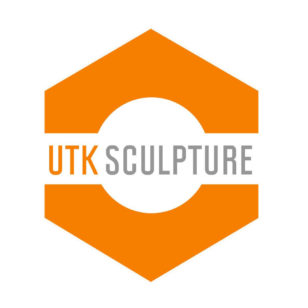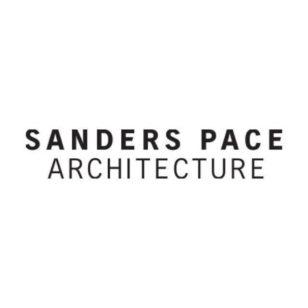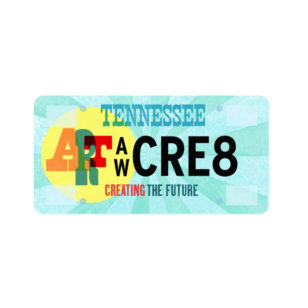INTERVIEW: DAVID UNDERWOOD
JUL. 17, 2025
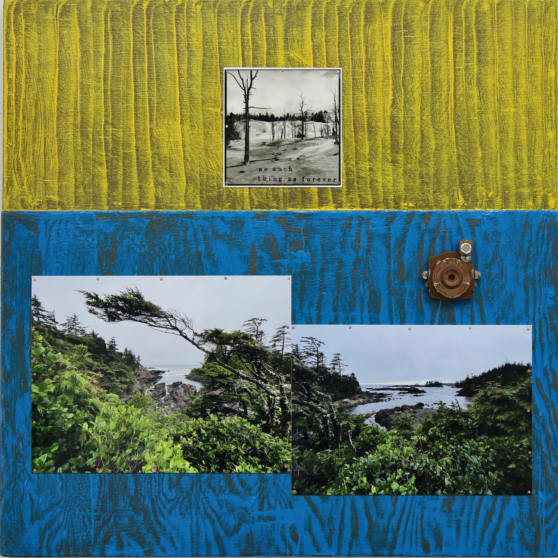
INTERVIEW: DAVID UNDERWOOD
JUL. 17, 2025
Elise Cochran: When would you say you first started experimenting with text alongside images and what drove you to do this?
David Underwood: I started adding text in some of my artworks in 2012, with an artwork titled, “Shift In Thinking.” Now some thirteen years later, my ongoing “image-text” series is the dominant body of my current work, with more than 250 artworks completed. I’ve always been interested in how the title of an artwork can possibly direct the viewer to either greater understanding of an artwork, or perhaps just add mystery to an artwork. I started adding text as a visual element in several works to accomplish hopefully a bit of both of those aspects: understanding and mystery.
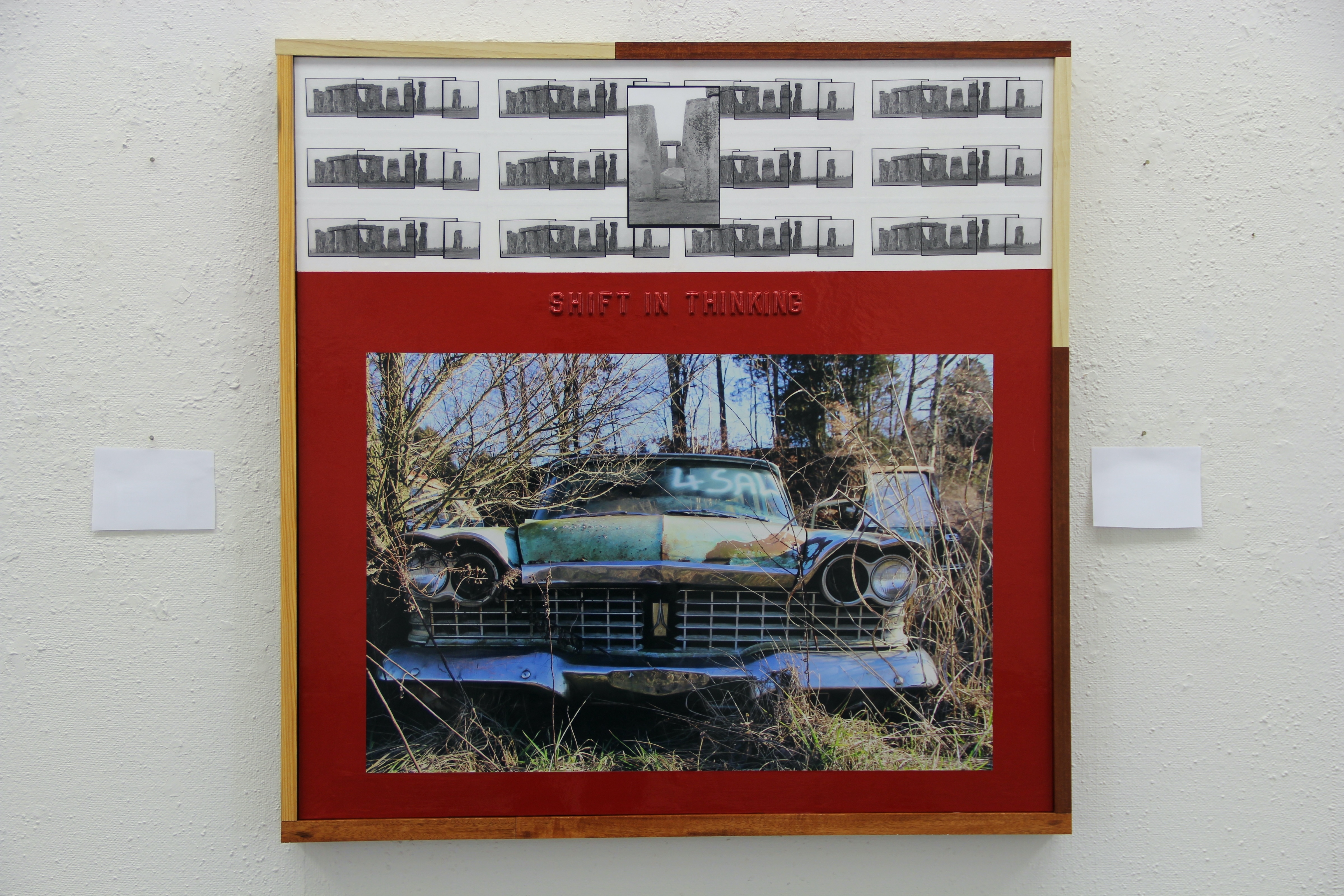
David Underwood, Shift In Thinking, 2012, acrylic, plastic lettering, original photographs, and clear over-varnishes on wood, with a funky hand-crafted mixed-species hardwood frame, 38" x 38" x 2"
EC: Has your approach to using text and images evolved over time? If so, what aspects of it have changed?
DU: My process of adding text into my work has evolved a bit, in that I have added several different fonts of rubber stamp letters, some letter stencils, and also allowed myself to occasionally use handwritten text. In terms of concept, I continue to develop and seek useable words and phrases from a variety of sources, including current news, contemporary poetry, and occasionally current scientific developments.
EC: You talk about how you like to leave your pieces open to the viewer’s interpretation. Would you expand on why this is important to you?
DU: Text in my artworks is intentionally ambiguous, in that it does not necessarily have an obvious relation to the images or abstractions within the work. I want the viewer to experience and contemplate my work long enough to try to make connections between the various images and perhaps with the text, and I find it intriguing that different people will find different associations and different meanings within the same artwork.
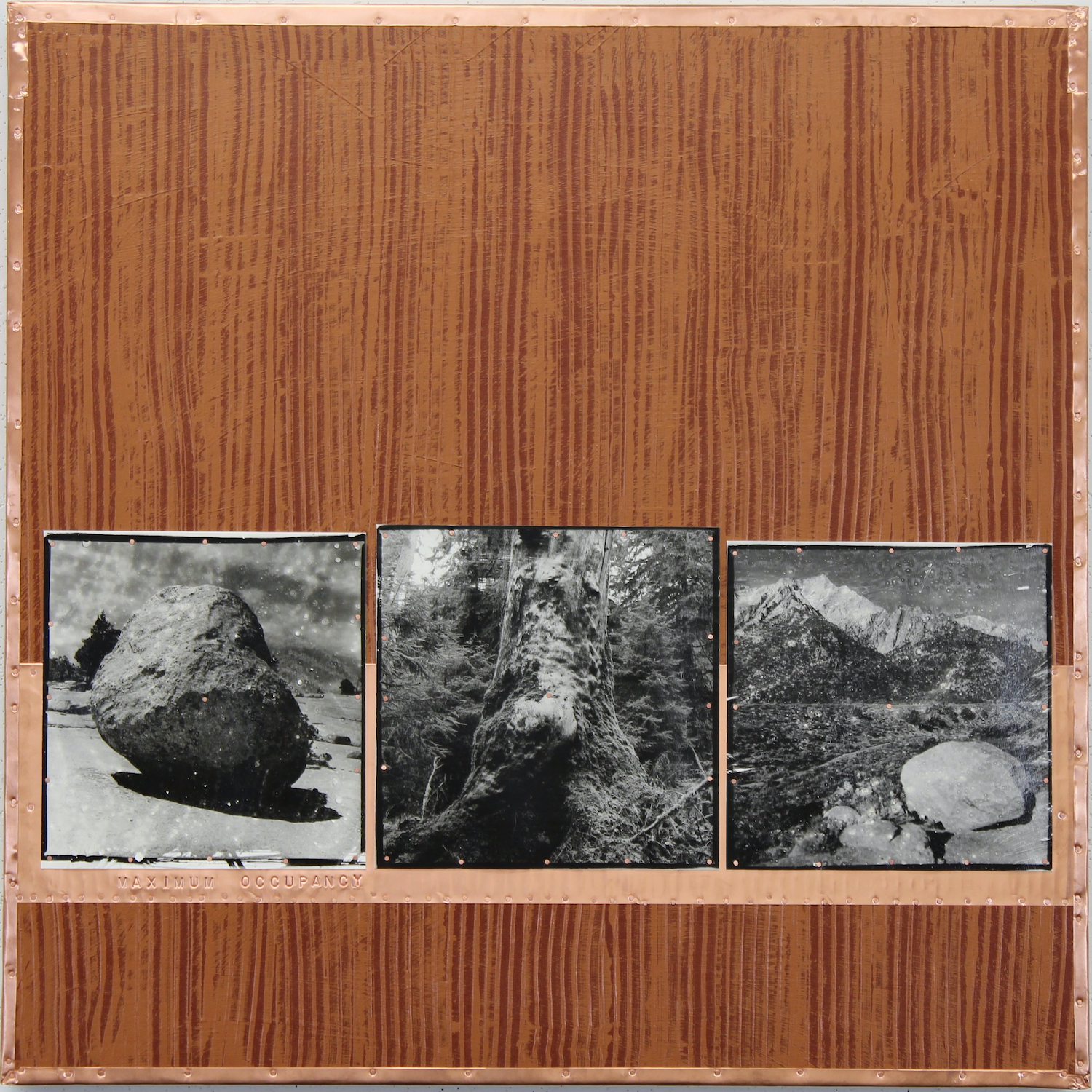
David Underwood, Maximum Occupancy, 2024, acrylic, liquid emulsion silver gelatin photographs on paper, embossed text on copper sheet metal, copper nails, and clear varnishes on wood, with a custom copper metal frame, 30” x 30” x 3”
EC: Does each piece have a particular significance/interpretation for you?
DU: Sometimes I have chosen to title/text an artwork because some of the included imagery has a specific connected meaning for me, but other times I have added text that really has no such connection. So I assemble and title my work in a variety of ways.
EC: Has your own interpretation of certain pieces changed during the creation process?
DU: Occasionally I will discover additional content connections of various photographs or text within my own work that I did not consciously intend, especially when I am looking at a work that I created a few years earlier and haven’t looked at for a while.
EC: Has somebody ever interpreted your work in a way you did not expect?
DU: Yes, viewers of my work often see meaning or connections in my work that I did not expect or intend, and this experience is always gratifying. I embrace varied interpretations of abstractions and ambiguity in artwork, and enjoy how each viewer brings their own background and experience to the event of sharing artwork.
EC: How would a viewer ideally interact with your artworks? What do you hope they come away with?
DU: I hope that viewers of my work spend enough time with each piece to discover something intriguing or meaningful, and come away with a personal interpretation or memory that resonates.
EC: You talk about your materials as important for your artworks. Is there a significance behind the copper you often incorporate into your pieces?
DU: Materialness and physicality are important in my work. The multiple photograph components are all original physical individual prints, not digital composites. I add other elements into my work such as painting, drawing, nails, staples, and occasionally sheet metal or collage objects to add to the handmade, individual uniqueness of each artwork. I currently really enjoy making mixed-media work because I am utilizing my interests and skills in photography, woodworking, painting, drawing, language, and assemblage, sometimes all in a single artwork.
EC: What does your day to day artistic practice look like? Are you always on the lookout for potential compositions and visual connections? What elements would something have to include to make you stop in your tracks to take a photograph of it?
DU: To some degree, artists are always “working,” always looking for subject matter or inspiration, and are constantly open to ideas and situations that facilitate creativity and innovative decision-making. As I go through my daily activities, and especially during travel, I am always on the lookout for subject matter to photograph. I’m also constantly seeking concepts, phrases, and language to use as text in my work, and these ideas may come from reading, current news, conversations, or observations of other art forms. I keep a handwritten daily journal in which I document work on new pieces, things photographed, books read, people or places visited, and ideas and sketches for potential new work.

David Underwood, No Such Thing As Forever, 2025, color photographs, ink on a silver gelatin photograph, acrylic, the lens from an antique Kodak folding camera, copper & steel nails, and clear varnishes on wood, 30" x 30" x 3.5"
EC: What does your process look like for creating each individual artwork in your Text/Image series? Do you often start with a particular idea, the text, or the images, or does it vary piece by piece?
DU: I work from several different angels, often from different starting points. Sometimes I start with compositions of photographs or painting, and then explore various text/titles that might strengthen that composition. Sometimes I start with a text/title that I really want to use, and then either make new visual components to go with that, or dig through my existing hundreds of already printed photographs to make a compatible composition. The choices of which photographs or other visual elements to combine can be content oriented decisions or might be primarily aesthetic decisions.
EC: Are there any artists who have influenced your art? If so, who were they and what aspects of your art making have they influenced?
DU: I have been inspired and influenced by many visual artists, and have had the privilege of visiting thousands of museums and galleries across the USA, Canada, and Europe over several decades. The way I compose and print individual photographs has been influenced by the work of Edward Weston, Ansel Adams, and Michael Kenna. I am inspired by the grid paintings and artwork by Agnes Martin, Sean Scully, and Jackie Windsor. The way I make composite photographs has been influenced by the work of David Hockney, Mike & Doug Starn, and Robert Rauschenburg. There are many other artists that I admire, and I feel privileged to be able to make work that I consider to be part of the rich continuum of mixed-media, photographic, and contemporary art.
David Underwood has been making unique fine art photographs and mixed media artworks for 40 years. His composite photography and mixed media work expand the language of photography beyond the limitations of single-frame imagery, and make significant contributions to the continuum of the history of image-text and photo/mixed-media artwork. His work is included in the permanent collections of 16 art museums around the USA, including the Smithsonian American Art Museum and the Nelson-Atkins Museum of Art. Underwood has held 36 solo exhibitions of his work, and had work included in more than 150 group exhibitions, most of which were juried by prominent curators and other art professionals. His fine artwork is currently represented by The Haen Gallery, in Asheville, North Carolina, and his stock photography is represented internationally by Universal Images Group.
Underwood was born and raised in Columbus, Ohio, the third of six children to a musician mother and an architect father. In 1982 he earned his BA in Photography from Carson-Newman College (now University) in Tennessee, where he attended because of the college's unique major in Photography, and to be near the hiking and outdoor opportunities of the Great Smoky Mountains National Park. With work in various 2-D and 3-D media, Underwood finished his Master of Fine Arts Degree in Studio Art at Florida State University in 1990, and was recruited to start teaching back at his undergraduate alma mater in Tennessee the same year.
Professor Underwood retired from teaching Art and Photography at Carson-Newman University in May 2025. He Chaired the Art Department for 13 years (2000 to 2013), and led his department through two successful accreditation cycles with the National Association of Schools of Art and Design. Over his 35 years at the university, he taught 22 different college courses, seven of which he initiated and created, and he updated the curriculum for the university’s major in Photography twice during his tenure. Over the 33 years he has served as the Director of the university’s two art galleries, Underwood directed and curated more than 300 exhibitions of work by invited professional artists and current students.
David is married to the poet and writer Susan O’Dell Underwood, who retired from her position as Professor of English and Director of the Creative Writing Program at Carson-Newman University. She has published three volumes of poetry, and in 2022 published the epic American novel GENESIS ROAD. Together, the couple have travelled and photographed in 49 USA states and 11 foreign countries, and have visited more than 150 national parks and monuments.
Elise Cochran is a Summer 2025 Intern for Tri-Star Arts, currently based in the Chattanooga area.
* images courtesy of the artist
